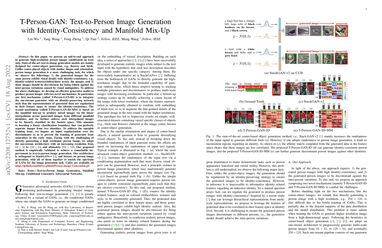T-Person-GAN: Text-to-Person Image Generation with Identity-Consistency and Manifold Mix-Up
In this paper, we present an end-to-end approach to generate high-resolution person images conditioned on texts only. State-of-the-art text-to-image generation models are mainly designed for center-object generation, e.g., flowers and birds. Unlike center-placed objects with similar shapes and orientation, person image generation is a more challenging task, for which we observe the followings: 1) the generated images for the same person exhibit visual details with identity-consistency, e.g., identity-related textures/clothes/shoes across the images, and 2) those images should be discriminant for being robust against the inter-person variations caused by visual ambiguities. To address the above challenges, we develop an effective generative model to produce person images with two novel mechanisms. In particular, our first mechanism (called T-Person-GAN-ID) is to integrate the one-stream generator with an identity-preserving network such that the representations of generated data are regularized in their feature space to ensure the identity-consistency. The second mechanism (called T-Person-GAN-ID-MM) is based on the manifold mix-up to produce mixed images via the linear interpolation across generated images from different manifold identities, and we further enforce such interpolated images to be linearly classified in the feature space. This amounts to learning a linear classification boundary that can perfectly separate images from two identities. Our proposed method is empirically validated to achieve a remarkable improvement in text-to-person image generation. Our architecture is orthogonal to StackGAN++ , and focuses on person image generation, with all of them together to enrich the spectrum of GANs for the image generation task. Codes are available on \url{https://github.com/linwu-github/Person-Image-Generation.git}.
PDF Abstract



 CUHK-PEDES
CUHK-PEDES